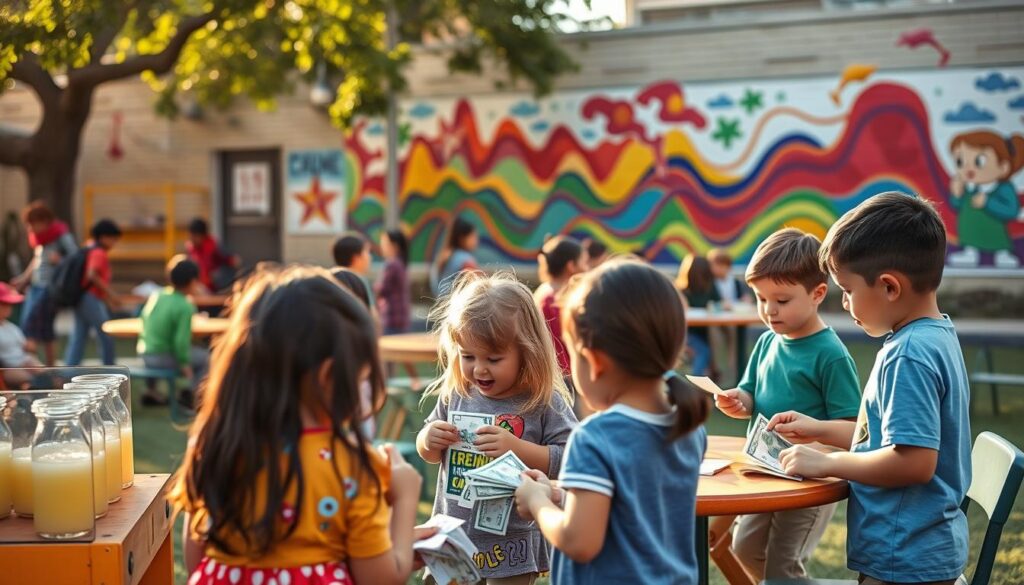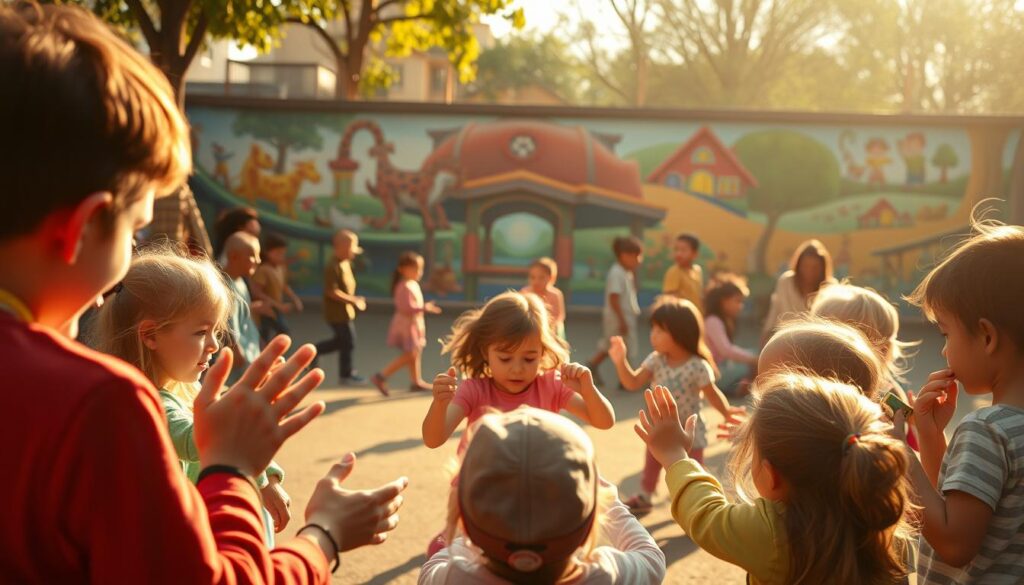Hi friends! I’m Zara Maddison, and I’m 12 years old. I own Assets for Kids. It’s where I teach other kids about money. I found something super cool to share!
Do you remember when everyone wanted the same trading cards? Then, no one cared anymore? Guess what? The grown-up world works exactly the same way!
I call this playground economics. Our school yard shows us real money patterns. Watching how crazes spread and fade helped me see the same waves in the big world.
Learning about economic cycles for kids isn’t boring. It’s like having a secret power. Once you see these patterns, you can make smart choices. These choices help you build wealth later.
Ready to discover how your everyday world can teach you to be rich? Let’s dive in!
What Are Economic Cycles and Why Should We Care?
You know how some things at school become super popular and then just disappear? Our whole economy works the same way! I’m Zara, and I’m 12 years old. I started Assetsforkids because I believe kids finance education should start early. Understanding economic cycles is a huge part of that.
Think about it this way. Remember when everyone was obsessed with fidget spinners? First, a few kids had them. Then suddenly everyone wanted one. Stores couldn’t keep them in stock! But then what happened? People got bored and moved on to something else.
Our economy does the exact same thing. Sometimes businesses are booming and people have lots of jobs and money to spend. Other times, things slow down and people become more careful with their cash. These ups and downs are called economic cycles, and they happen over and over again.

- Expansion: Like when a new trend starts catching on – more people are getting interested
- Prosperity: When everyone’s into it – businesses are making money and people have jobs
- Contraction: When things start getting less exciting – people spend less money
- Recession: When hardly anyone cares anymore – fewer jobs and less spending
But why should we care about this stuff? Because understanding these patterns helps us make smart decisions about our money! Even if you only get allowance or birthday money right now, knowing about economic cycles prepares you for the future.
When you understand how money moves through the economy, you can save during good times and be ready for tough times. This is what financial literacy kids like us need to learn early. It’s like having a superpower that helps you see what’s coming next!
Understanding Economic Cycles Through Kids Playground Economic: The Four Phases
Economic patterns repeat in cycles. I’ve seen all four phases at my school. Trends come and go, just like in the real economy.
The Pokemon Card Rush at My School
Last year, Pokemon cards were all the rage at my school. It started small during the expansion phase. Only three kids had cards, and they traded quietly during lunch.
Then, the prosperity phase hit, and things got crazy. Everyone wanted Pokemon cards. Kids brought their allowance money to school every day. Prices skyrocketed.

The contraction phase came when people got bored. Trades slowed down. Kids stopped bringing money for cards. Prices dropped.
Then, the recession phase hit. Nobody wanted Pokemon cards anymore. Cards were forgotten in backpacks. The whole economy crashed.
This pattern repeats in the real economy too. Businesses grow, reach their peak, slow down, and sometimes struggle. Then, the cycle starts again.
Signs That Good Times Are Rolling
I know when good times are coming. My parents seem less stressed about money. They might even suggest getting pizza instead of cooking dinner.
Around town, I see more signs. Restaurants are packed on weekends. New stores open in the mall. My friends talk about family vacations.
At school, kids bring better lunches. They have newer clothes and backpacks. Parents volunteer for more field trips. The school has more money for supplies and activities.
These signs connect to real economic indicators. When families spend more, businesses make more money. When businesses do well, they hire more people. It’s all connected, and you can see it happening right around you if you know what to look for.
Real Playground Economics I’ve Seen With My Own Eyes
Let me share some cool economic patterns I’ve seen. As someone who loves kids finance education, I always look for examples.
Last summer, our local arcade faced a tough time. Fewer kids came because they were saving for school. The owner had to think fast.
He started offering buy-one-get-one-free deals on game tokens. He also lowered prices on food and drinks. This is what big businesses do to bring customers back.
The ice cream truck in our neighborhood taught me about economic cycles. It comes every day at 3:30 PM during school. But in winter, it only comes on weekends.
The driver changes prices based on where he goes. In richer areas, he charges more. In poorer areas, he offers deals.
I’m fascinated by playground economics during lunch trades at school. Kids start by swapping simple things. The smart ones grow their “business” when others want what they have.
But when trends change, these kids have to offer deals. They might give extra snacks or trade two for one. It’s like watching real business cycles at our lunch tables.
Even our local mall shows economic patterns. Over the past year, three stores closed and two new ones opened. The stores that survived had to change what they sold or offer bigger discounts.
- Successful stores adapted their products to what people actually wanted
- Smart businesses offered payment plans and special promotions
- Failed stores kept doing the same things without changing
These examples show that economic cycles are real. They’re happening all around us every day. The businesses that survive are the ones that pay attention and adapt quickly.
Spotting Economic Patterns in Your School Right Now
Want to be an economic detective at school? Look for economic patterns in your hallways and classrooms. It’s fun once you know what to look for!
I made a simple checklist for you. First, notice what kids do for lunch. Are they packing lunches or buying from the cafeteria? This might show if families are saving money.
Then, check out school fundraisers. Are they making more or less money? When families have more money, fundraisers do well. But when money is tight, they struggle.
Also, watch afterschool activities. Are new clubs starting, or are some being canceled? New clubs mean families might be spending more. Canceling clubs could mean they’re spending less.
Here are more clues to look for:
- Trading cards and toys – are kids trading more or buying new ones?
- Birthday parties – are they getting bigger or smaller?
- Field trip participation – are fewer kids signing up?
- School supplies – are kids sharing more or buying their own?
These small signs show big trends in our economy. When I see more lunch packing, I know families might be saving money. This helps me understand the wider world.
Teaching financial literacy kids early is very important. Research shows kids play big roles in the economy, even when we don’t see it.
Start being an economic detective today! Watch these patterns around you. You’ll learn a lot about money and economics just by observing what happens at school.
Using Playground Economics to Build Real Wealth Later
Learning about playground economics is cool. You can start wealth building for children right now. It teaches us when to save and when to spend.
Some kids always have money for fun things. They follow the rule: buy low, sell high. This means buying things when they’re cheap and selling when they’re in demand.
I use this strategy too. When a video game is on sale, I buy it. I don’t wait until everyone wants it. The same goes for trading cards – I collect them when they’re not popular, then trade them when they are.
It’s smart to save your allowance during good times. While friends spend all their money, you save some. Then, when something cool comes up, you have money ready.
This kids finance education way works because money cycles repeat. Good times don’t last forever, and neither do bad times. Being ready for both is key.
| Good Financial Timing | Bad Financial Timing | Smart Strategy |
|---|---|---|
| Buy games during sales | Buy at full price when popular | Wait for discounts, plan purchases |
| Save allowance regularly | Spend everything immediately | Save 30% of money received |
| Collect items before trends | Buy when everyone else wants them | Research what might become popular |
| Trade when demand is high | Sell when nobody’s interested | Watch for peak interest moments |
These habits will help you make smart financial decisions as you grow up. Start practicing now, and you’ll be amazed at how much money you can build over time.
Conclusion
I think it’s pretty amazing that we kids can figure out something that confuses so many grown-ups. By watching playground economics, we’re already learning patterns that most adults never notice. The trading cards, the lunch swaps, the popularity cycles – they’re all mini versions of real economic cycles for kids to understand.
You don’t need to wait until you’re older to start being smart with money. Even if you only have five dollars from your allowance, you can practice making good choices. Maybe you save half and spend half. Maybe you look for things that might be worth more later.
Every time you spot these patterns at school, you’re training your brain to see opportunities. When you notice that Pokemon cards are getting popular again, or that everyone wants the same snack, you’re seeing economic cycles in action.
I created Assetsforkids because I want other kids to have these same “aha” moments about money. When we understand how money and economics work now, we’ll have superpowers when we grow up. We’ll know how to build real wealth and make smart decisions that other people miss.
Keep watching those playground patterns. Keep asking questions about why things happen. Your future millionaire self will thank you for starting to think like this today.